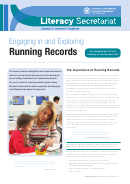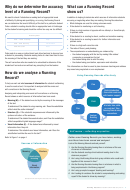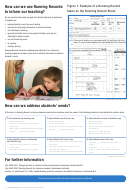Running Records Reading Instruction Page 2
ADVERTISEMENT
How can we make sure our
Why do we take Running Records?
Running Records are reliable?
While the same procedure for taking a Running Record is always used,
the information we gain from the Running Record is used for two distinctly
Teachers need to be taking the Running Records, making sure they are:
different purposes:
•
using standard ways of recording
1. Site report data collection
•
using any ‘seen’ text, ie one which has been previously introduced
2. Informing our classroom programs.
and read by the student, but not one which has been taken home
to practise
1. Site report data collection
•
using a blank piece of paper or a Running Record form, eliminating
the need for additional preparation
Schools are asked to collect data about reading levels for Year 1 and 2
•
noting all attempts or parts of attempts the student makes when
students by taking Running Records.
reading the book
•
Using this data enables teachers to monitor the progress of learners;
•
not intervening while the student is reading
and leaders can monitor the effectiveness of the agreed whole site
•
inviting the student to read a passage of 100–200 words, or the entire
approach to literacy improvement.
book if the book has less than 100 words
•
Combined with other evidence, this data supports continuously
•
recording, at the end of the Running Record, how the reading sounded
informing our practices and decisions at the learner, site, regional and
eg whether the reading was smooth and phrased or read word by word.
system level.
(Literacy Achievement for All Learners in All Communities: A Model
How to take a Running Record
For Literacy Improvement.)
1. Select a text at the student’s appropriate reading level and one that
2. Informing our classroom programs
has been previously introduced and read by the student.
As well as the Running Records we take for data collection, we also analyse
2. Invite the student to read the text.
and reflect on other Running Records taken regularly in our classrooms.
3. As the student reads, use the conventions to note the student’s
These Running Records assist us in our classroom teaching and help us
reading behaviours.
to bring about change in reading outcomes.
4. Score and analyse the Running Record.
Running Records taken for classroom programs inform and guide teaching
5. Use this information to plan for future teaching.
and help to:
•
capture progress
•
assess text difficulty
•
show reading behaviours by allowing us to see HOW learners
read independently
•
ensure texts are well matched to students
•
group learners with similar needs
•
cater for individual differences
•
provide explicit feedback to students and their parents.
A Running Record is a documentation of a child’s
actual reading of text, providing both quantitative
and qualitative information.
(Fountas & Pinnell, Guided Reading p 78)
Self review – a collaborative approach
As a staff, look at your school’s Running Records data together
and discuss:
1. What did your school’s results show this year?
2. What patterns do you notice in your data?
3. What change over time are you seeing in your data?
4. How did your school’s results compare with your expectations?
5. What goals can you set yourselves for your next data collection?
2 |
Running Records Consultative Draft February 2012
ADVERTISEMENT
0 votes
Related Articles
Related forms
Related Categories
Parent category: Education
 1
1 2
2 3
3 4
4








